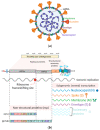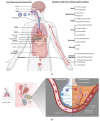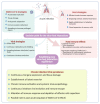Insights into SARS-CoV-2 Persistence and Its Relevance
- PMID: 34072390
- PMCID: PMC8228265
- DOI: 10.3390/v13061025
Insights into SARS-CoV-2 Persistence and Its Relevance
Abstract
Severe acute respiratory syndrome coronavirus 2 (SARS-CoV-2), the causative agent of coronavirus disease 2019 (COVID-19), continues to wreak havoc, threatening the public health services and imposing economic collapse worldwide. Tailoring public health responses to the SARS-CoV-2 pandemic depends on understanding the mechanism of viral replication, disease pathogenesis, accurately identifying acute infections, and mapping the spreading risk of hotspots across the globe. However, effective identification and isolation of persons with asymptomatic and mild SARS-CoV-2 infections remain the major obstacles to efforts in controlling the SARS-CoV-2 spread and hence the pandemic. Understanding the mechanism of persistent viral shedding, reinfection, and the post-acute sequalae of SARS-CoV-2 infection (PASC) is crucial in our efforts to combat the pandemic and provide better care and rehabilitation to survivors. Here, we present a living literature review (January 2020 through 15 March 2021) on SARS-CoV-2 viral persistence, reinfection, and PASC. We also highlight potential areas of research to uncover putative links between viral persistence, intra-host evolution, host immune status, and protective immunity to guide and direct future basic science and clinical research priorities.
Keywords: COVID-19; PASC; SARS-CoV-2; coronaviruses; long COVID; reinfection; viral persistence.
Conflict of interest statement
The authors declare no conflict of interest.
Figures





Similar articles
-
Persistent Detection and Infectious Potential of SARS-CoV-2 Virus in Clinical Specimens from COVID-19 Patients.Viruses. 2020 Dec 3;12(12):1384. doi: 10.3390/v12121384. Viruses. 2020. PMID: 33287245 Free PMC article. Review.
-
How SARS-CoV-2 (COVID-19) spreads within infected hosts - what we know so far.Emerg Top Life Sci. 2020 Dec 11;4(4):371-378. doi: 10.1042/ETLS20200165. Emerg Top Life Sci. 2020. PMID: 33269805 Free PMC article. Review.
-
Understanding the outcomes of COVID-19 - does the current model of an acute respiratory infection really fit?J Gen Virol. 2021 Mar;102(3):001545. doi: 10.1099/jgv.0.001545. Epub 2020 Dec 15. J Gen Virol. 2021. PMID: 33331810 Free PMC article.
-
Mild SARS-CoV-2 Illness Is Not Associated with Reinfections and Provides Persistent Spike, Nucleocapsid, and Virus-Neutralizing Antibodies.Microbiol Spectr. 2021 Oct 31;9(2):e0008721. doi: 10.1128/Spectrum.00087-21. Epub 2021 Sep 1. Microbiol Spectr. 2021. PMID: 34468184 Free PMC article.
-
Prospects for durable immune control of SARS-CoV-2 and prevention of reinfection.Nat Rev Immunol. 2021 Jun;21(6):395-404. doi: 10.1038/s41577-021-00550-x. Epub 2021 Apr 29. Nat Rev Immunol. 2021. PMID: 33927374 Free PMC article. Review.
Cited by
-
A rare case of SARS-CoV-2 and influenza A virus super-infection.Diagn Microbiol Infect Dis. 2022 Sep;104(1):115743. doi: 10.1016/j.diagmicrobio.2022.115743. Epub 2022 Jun 16. Diagn Microbiol Infect Dis. 2022. PMID: 35834915 Free PMC article.
-
Host-Virus Interface in Persistent SARS-CoV-2 Infections: Viral Characteristic Evolution and Gene Expression Profiling Analysis.Int J Mol Sci. 2025 Jun 27;26(13):6221. doi: 10.3390/ijms26136221. Int J Mol Sci. 2025. PMID: 40649996 Free PMC article.
-
Current and emerging immunomodulators for treatment of SARS-CoV2 infection (COVID-19).Expert Opin Pharmacother. 2022 Apr;23(5):623-628. doi: 10.1080/14656566.2022.2035360. Epub 2022 Feb 1. Expert Opin Pharmacother. 2022. PMID: 35103549 Free PMC article.
-
Conjugation with 8-arm PEG and CRM197 enhances the immunogenicity of SARS-CoV-2 ORF8 protein.Int Immunopharmacol. 2022 Aug;109:108922. doi: 10.1016/j.intimp.2022.108922. Epub 2022 Jun 6. Int Immunopharmacol. 2022. PMID: 35687905 Free PMC article.
-
Does SARS-CoV-2 Induce IgG4 Synthesis to Evade the Immune System?Biomolecules. 2023 Sep 1;13(9):1338. doi: 10.3390/biom13091338. Biomolecules. 2023. PMID: 37759738 Free PMC article.
References
-
- WHO Coronavirus Disease (COVID-19) Pandemic. [(accessed on 19 April 2021)]; Available online: https://www.who.int/emergencies/diseases/novel-coronavirus-2019.
Publication types
MeSH terms
LinkOut - more resources
Full Text Sources
Medical
Miscellaneous

